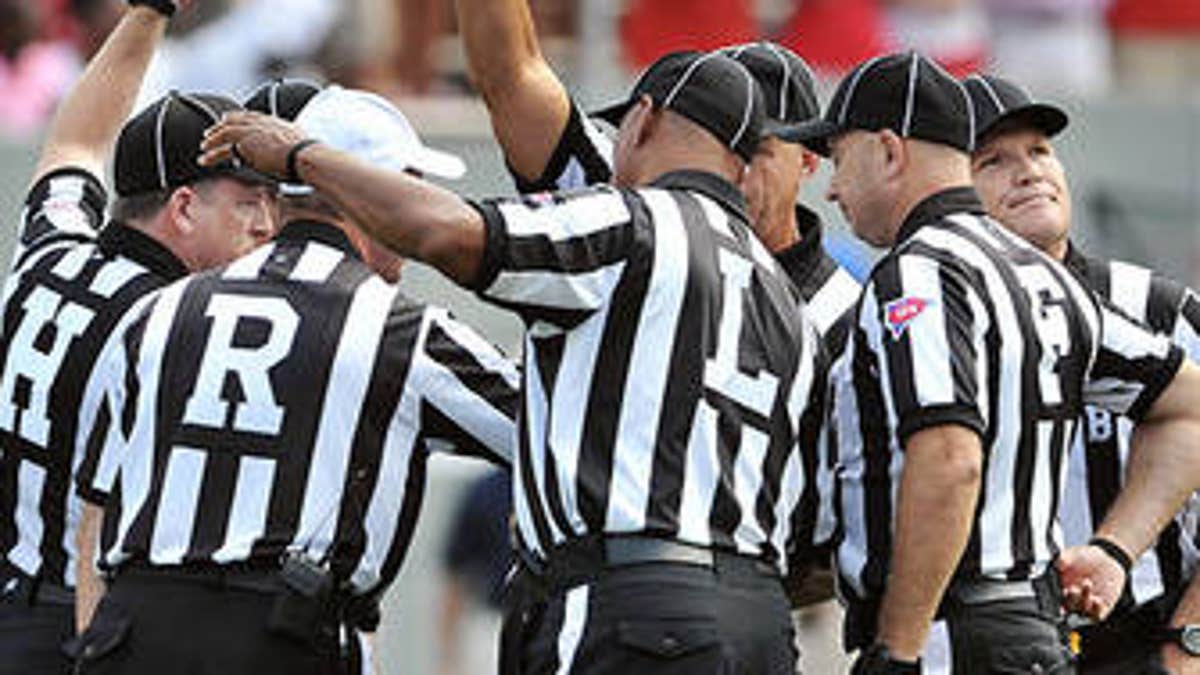
When you make a vow, it's a commitment. It's a solemn promise you make to someone or something.
And I have to break one.
I'm sure my wife, Gail, is a little nervous at this point. Don't worry, honey, it's not you.
This vow was to myself and my crew, and I made it a few weeks ago here in the cube I call home on the weekends at the FOX Network Center. I vowed never to talk about targeting again because it's my least favorite rule in NCAA football.
Sorry crew, I can't do it.
In the early games we were watching on Saturday, there were four targeting calls in three different games -- two in the Georgia-Vanderbilt; South Carolina-Tennessee; Florida-Missouri -- and three of the four ejections were upheld in replay.
You can blame my vow break on the first one in the Georgia-Vandy game.
Here was the situation: Vanderbilt had the ball, second-and-10 at the Georgia 27-yard line with 11:28 in the second quarter. Quarterback Austyn Carta-Samuels completed a 7-yard pass to Wesley Tate. On the play, Georgia's Ray Drew hit Carta-Samuels and was called for a targeting foul and was ejected from the game.
Drew hit the quarterback, but didn't lower his head or didn't throw a shoulder or forearm to the head or neck area of the quarterback. If you want to call it roughing the passer to protect the quarterback, I buy that. But targeting? No way.
If that was targeting, then it further strengthens my belief that a lot of people -- including me, the replay assistants and officials -- have no idea what targeting is either.
The question then becomes, who's to blame for this rule -- and all of the other rules that people don't like?
The first, and most popular target, is the officials. That would be wrong.
The second target would be me, from many of my nearly 175,000 twitter followers. That would also be wrong.
Let's put the blame where it belongs --on the NCAA Rules Committee. They make the rules decisions.
And who is on the committee? Take a look at the dandy dozen.
Alfred B. White: Associate commissioner, Conference USA
Todd Berry: Head coach, University of Louisiana at Monroe (Sun Belt Conference)
Troy Calhoun: Head coach, Air Force Academy (Mountain West Conference)
Ken Beazer: Athletic director, Southern Utah University (Big Sky Conference)
Thomas E. Yeager: Commissioner, Colonial Athletic Association
Craig Bohl: Head coach, North Dakota State (The Summit League)
Will Prewitt: Commissioner, Great American Conference
Keith Allen: Head coach, Southwest Baptist (Mid-America Athletic Association)
Peter Rossomando: Head coach, University of New Haven (Northeast-10 Conference)
Gregory A. Wallace: Athletic Director, Grinnell College (Midwest Conference)
Michael Mattia: Associate Director, John Hopkins (Centennial Conference)
Brian Surace: Head coach, Farleigh Dickinson University (Mid-Atlantic Conference)
Part of the bigger issue is how relevant the NCAA really is. How can you pass a rule that is pertinent to major conferences, when there's not a single person on the committee that represents one of the major conferences?
There's nobody on the committee from the SEC, Big 10, Pac-12, Big 12 or ACC.
That seems outrageous.
The highest ranking person might be Alfred White of Conference USA and he's the associate commissioner. Not a single member from any of the "BCS schools" is on the committee, though Arkansas coach Bret Bielema was on the committee when it voted on the rule change in February. Maybe that's another reason why there's talk that the BCS schools will pull out of the NCAA.
By the way, there's not a single official or former official on the committee.
That's embarrassing. All of it.
So how is the committee selected? Each conference nominates someone, and there has to be at least one member from the FBS, FCS, Division II and Division III on the committee.
The NCAA Rules Committee passed the targeting rule in February and the Playing Rules Oversight Panel approved the change in March.
The rule addresses the committee's concern about player safety by taking more measures to remove targeting or above the shoulder hits on defenseless players out of the game. It means that discipline for players flagged for violations will mirror the penalty for fighting. If the foul occurs in the second half or overtime of a game, the player is ejected for the remainder of the game and the first half of the next contest.
Fighting is not a football act. An attempt to make a tackle or a block that turns out to be targeting is a football act.
The committee did allow for a review, but only on the ejection part.
Rogers Redding, the NCAA's national coordinator for college officials, told the New York Times that they did not want to open a "Pandora's box" for review of more penalties or "officiating from the booth."
And therein lies the rub.
Many people, including Alabama coach Nick Saban, who recently lost one of his best players to the targeting rule, don't like the rule and want it changed.
Saban said this at a recent press conference: "If you can review a play to say a guy should be ejected or not be ejected, to me, you should review it to say it was a penalty or not a penalty. That's not what the rule is. I'm giving you my opinion. That's something the rules committee did.''
Yes they did. And it needs to be changed.
I make a vow right now to not talk about targeting until they do.
Well, maybe.
The original article can be found at FOXSports.com: NCAA rules committee must change.
